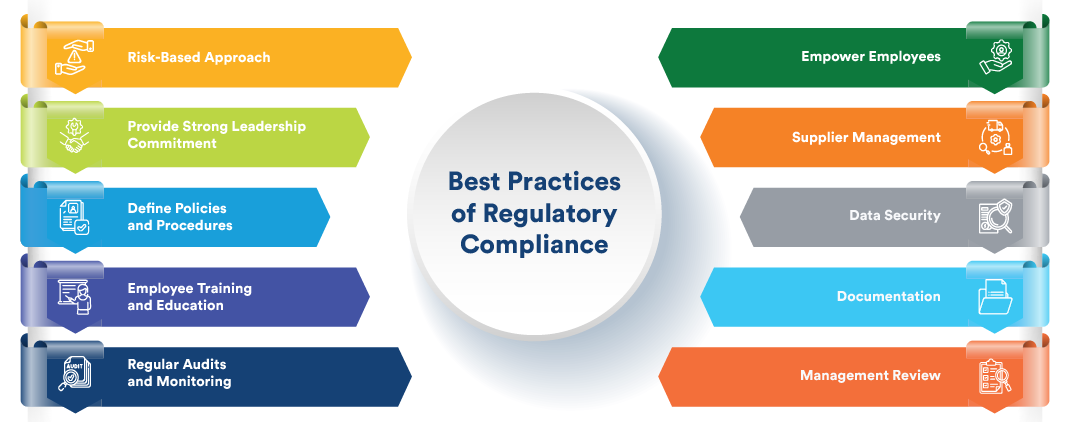In highly regulated industries like life sciences, pharmaceuticals, and manufacturing, building a strong regulatory compliance culture is essential for long-term success. Companies must navigate complex regulations such as 21 CFR Part 11 compliance and manage intricate supplier networks, making Regulatory Compliance Management a top priority. This article explores how organizations can foster a culture centered on compliance while addressing the challenges faced by VPs, Directors of Quality, CEOs, and Quality Assurance Managers.
1. Understanding Regulatory Compliance Management
What is Regulatory Compliance Management?
Regulatory compliance management involves ensuring that an organization adheres to legal and regulatory requirements relevant to its industry. This process is especially critical in industries like pharmaceuticals, where 21 CFR Part 11 compliance dictates how electronic records and signatures are handled. An effective compliance culture starts with understanding the regulations that impact the company’s operations.
Why Compliance Management is Key for Growth
Building a strong Compliance Management framework ensures that your organization is protected from regulatory risks. Companies in complex sectors like aerospace or medical devices must establish robust compliance processes that also integrate with supplier management systems to mitigate risks from external vendors.
2. Leadership Commitment to Compliance
Setting the Tone at the Top
Creating a compliance culture begins with leadership. The commitment from top management, such as CEOs and VPs of Quality, is crucial for embedding regulatory compliance management practices across the organization. Leaders must communicate the importance of adhering to regulatory frameworks such as 21 CFR Part 11 compliance and ensure that all departments are aligned.
Aligning Compliance with Business Strategy
For companies in sectors like discrete and complex manufacturing, aligning compliance with the overall business strategy is essential. This requires close collaboration between compliance teams and departments such as supplier management to ensure that every aspect of the business meets regulatory standards while pursuing growth.
3. Developing a Compliance Training Program
Regular Training on Compliance Management
Training is a cornerstone of a compliance-driven culture. Regulatory requirements are constantly evolving, especially in industries such as medical devices, where non-compliance can have severe consequences. Training should focus on 21 CFR Part 11 compliance, quality assurance, and supplier management, ensuring that employees across all levels understand their roles in maintaining compliance.
Role-Specific Training Programs
Tailor your training programs to the needs of various departments. For example, those involved in supplier management should receive specific guidance on compliance risks related to third-party vendors, while quality assurance teams should focus on maintaining regulatory compliance management processes.
4. Implementing a Risk-Based Approach to Compliance
Prioritizing Compliance Management Based on Risk
In complex industries like aerospace and pharmaceuticals, organizations must adopt a risk-based approach to compliance. This involves identifying areas where non-compliance could have the most significant impact, such as failing to meet 21 CFR Part 11 compliance requirements, and allocating resources to mitigate these risks.
Integrating Supplier Management into Compliance
Suppliers can be a major source of compliance risk. By integrating Supplier Management into your regulatory compliance management framework, you can ensure that third-party vendors meet all necessary regulations, reducing the likelihood of non-compliance throughout the supply chain.
5. Utilizing Technology for Compliance Monitoring
Leveraging Automated Compliance Management Systems
In today’s digital era, automated solutions are indispensable for maintaining compliance. Advanced compliance management systems can monitor adherence to regulations like 21 CFR Part 11 compliance in real-time, ensuring that all electronic records are accurate and secure.
Supplier Management Technology
For industries with complex supply chains, managing suppliers through automated platforms can enhance supplier management and reduce compliance risks. These systems track the compliance status of suppliers, ensuring that all partners meet regulatory standards.
6. Continuous Improvement in Compliance Management
Regular Audits and Reviews
To build a sustainable compliance culture, companies must regularly audit their regulatory compliance management processes. Continuous audits allow organizations to identify areas for improvement and ensure adherence to evolving regulations such as 21 CFR Part 11 compliance.
Supplier Audits
Auditing your supply chain is just as crucial as internal reviews. Companies must ensure that supplier management practices are regularly assessed to prevent compliance breaches from external partners.
7. Encouraging Cross-Departmental Collaboration
Breaking Down Silos in Compliance Management
Compliance is a shared responsibility that demands collaboration from all departments within the organization. By fostering communication between quality assurance, IT, legal, and supplier management, companies can ensure that everyone is aligned in maintaining regulatory compliance management.
Enhancing Supplier Relationships
Collaborating closely with suppliers is essential for supplier management. Developing long-term partnerships with trusted vendors can reduce compliance risks and ensure smoother operations within your organization.
8. Measuring the Effectiveness of Compliance Efforts
Compliance KPIs
Organizations must develop key performance indicators (KPIs) to measure the effectiveness of their regulatory compliance management programs. This could include metrics related to adherence to 21 CFR Part 11 compliance standards, the number of compliance-related incidents, and supplier audit results.
Supplier Management Metrics
For companies dealing with large supply chains, tracking supplier management performance is equally important. This involves measuring the compliance rates of third-party vendors and identifying areas where corrective actions are needed.
Conclusion
In an increasingly regulated world, fostering a strong culture of compliance is not optional—it’s a necessity. With the complexities of regulatory compliance management growing, particularly in industries such as pharmaceuticals, medical devices, and aerospace, organizations must have robust systems in place. ComplianceQuest offers advanced solutions that integrate compliance management, supplier management, and 21 CFR Part 11 compliance to ensure that companies stay ahead of regulatory changes. Its innovative platform supports continuous improvement and helps companies in life sciences and manufacturing industries build a resilient compliance culture, making it essential for businesses in 2024 and beyond.





Comments